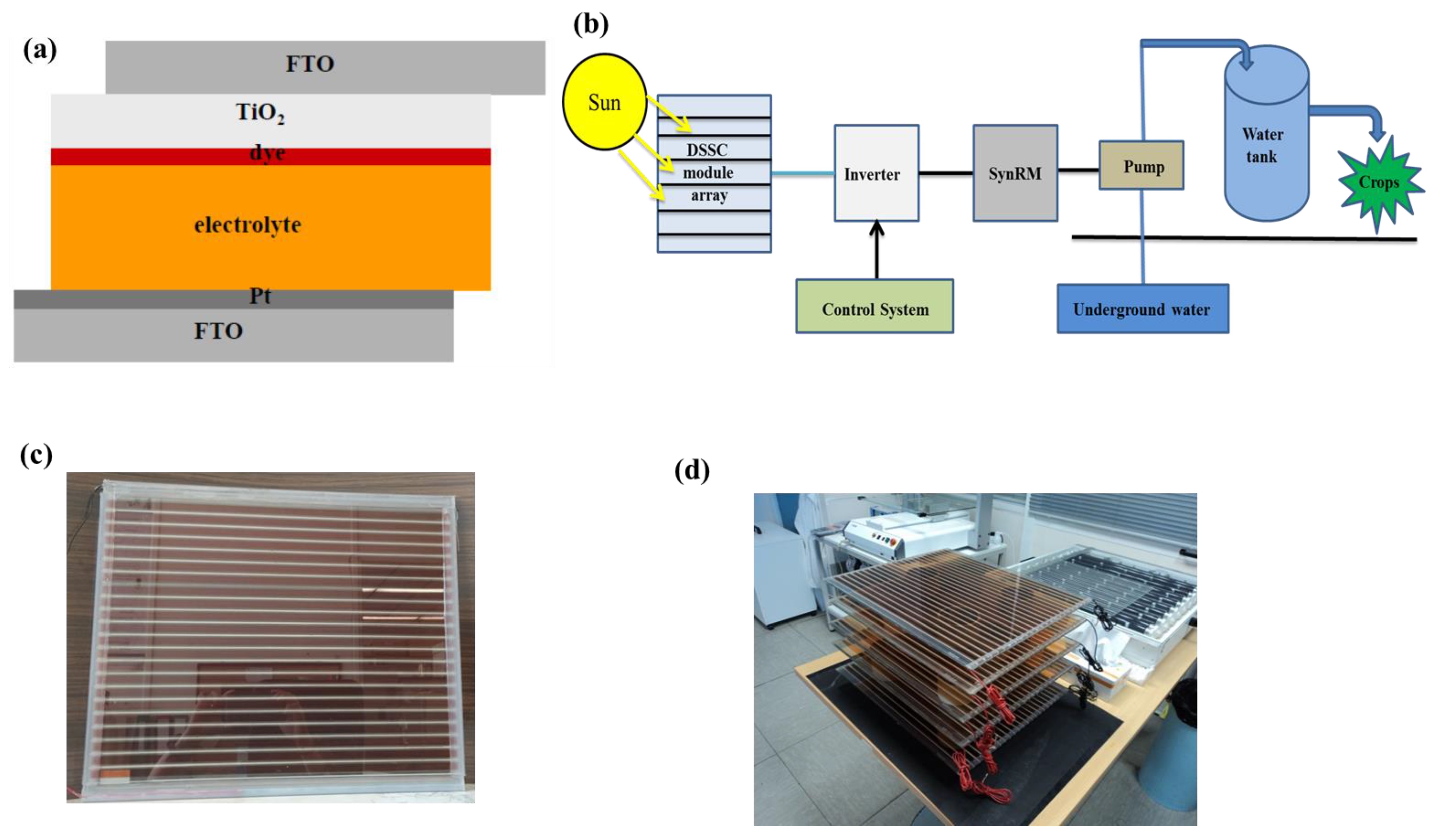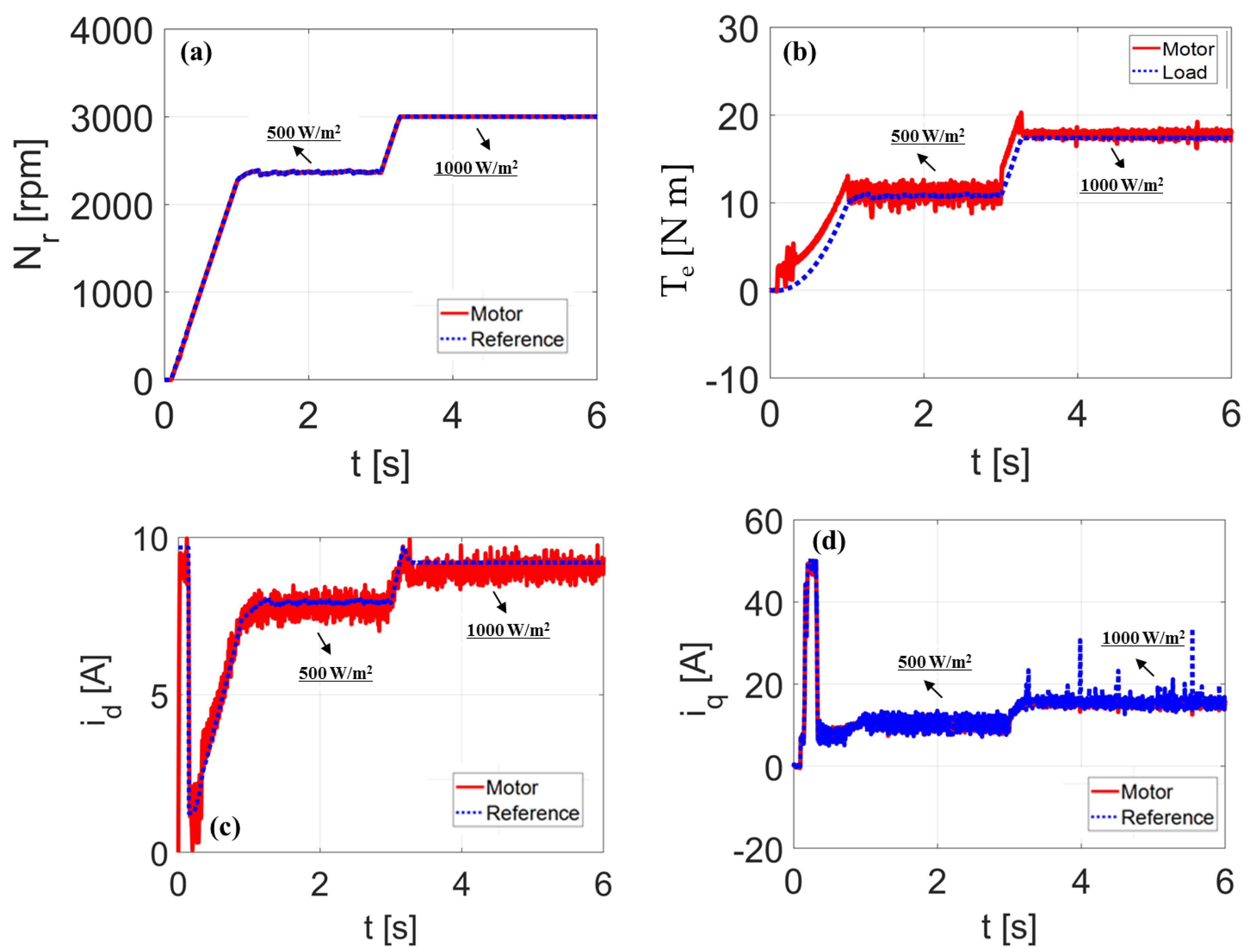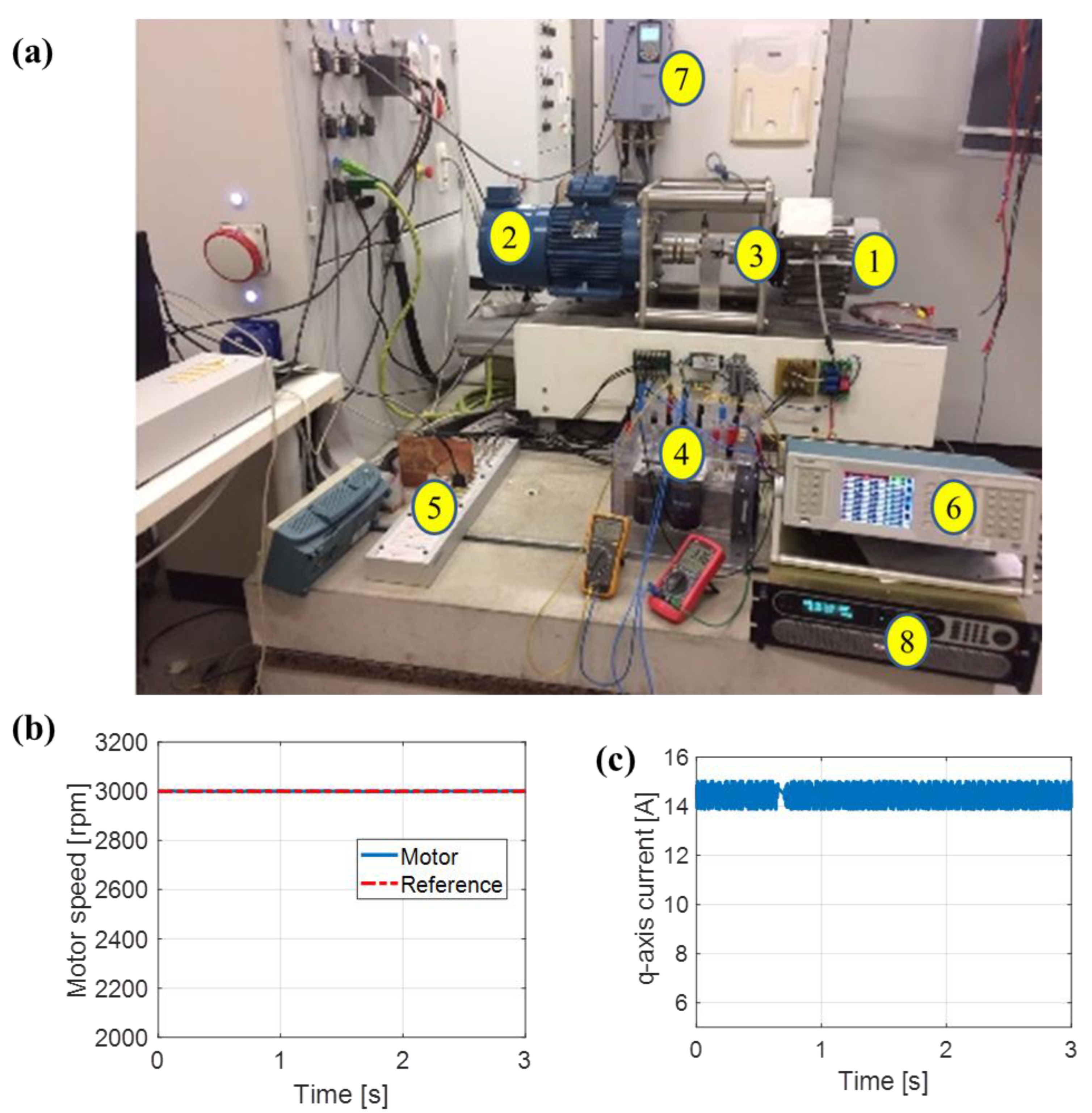Employing Dye-Sensitized Solar Arrays and Synchronous Reluctance Motors to Improve the Total Cost and Energy Efficiency of Solar Water-Pumping Systems
Abstract
:1. Introduction
2. The Water-Pumping System Fed by DSSC Module Array
2.1. DSSC-Based Water-Pumping System Structure
2.2. Modeling of the Proposed Water-Pumping System
2.2.1. DSSC Array
2.2.2. Three-Phase Inverter Modeling
2.2.3. SynRM Modeling
2.2.4. Centrifugal Pump Modeling
3. The Proposed Control System
3.1. Field-Oriented Control (FOC) Technique
3.2. Maximum Power Point Tracing Technique
3.3. The Complete Proposed Pumping System Performance
4. Experimental Confirmation
5. Conclusions
Author Contributions
Funding
Data Availability Statement
Conflicts of Interest
References
- Ahmed, U.; Alizadeh, M.; Rahim, N.A.; Shahabuddin, S.; Ahmed, M.S.; Pandey, A.K. A comprehensive review on counter electrodes for dye sensitized solar cells: A special focus on Pt-TCO free counter electrodes. Sol. Energy 2018, 174, 1097–1125. [Google Scholar] [CrossRef]
- Yoosuf, M.; Pradhan, S.C.; Soman, S.; Gopidas, K.R. Triple bond rigidified anthracene-triphenylamine sensitizers for dye-sensitized solar cells. Sol. Energy 2019, 188, 55–65. [Google Scholar] [CrossRef]
- Wu, H.; Xie, X.; Zhang, J.; Li, S.; Shen, Z.; Yuan, Y. Low-energy-gap organic photosensitizers with phenalenothiophene and benzoindenothiophene as primary electron-donors for durable dye-sensitized solar cells. J. Power Sources 2020, 451, 227748. [Google Scholar] [CrossRef]
- Abdellah, I.M.; El-Shafei, A. Synthesis and characterization of novel tetra anchoring A2-D-D-D-A2 architecture sensitizers for efficient dye-sensitized solar cell. Sol. Energy 2020, 198, 25–35. [Google Scholar] [CrossRef]
- Patil, S.S.; Mane, R.M.; Mali, S.S.; Hong, C.K.; Bhosale, P.N. Facile designing and assessment of photovoltaic performance of hydrothermally grown kesterite Cu2ZnSnS4 thin films: Influence of deposition time. Sol. Energy 2020, 201, 102–115. [Google Scholar] [CrossRef]
- Maddah, H.A.; Berry, V.; Behura, S.K. Biomolecular photosensitizers for dye-sensitized solar cells: Recent developments and critical insights. Renew. Sustain. Energy Rev. 2020, 121, 109678. [Google Scholar] [CrossRef]
- Duvva, N.; Chilakamarthi, U.; Giribabu, L. Recent developments in tetrathiafulvalene and dithiafulvalene based metal-free organic sensitizers for dye-sensitized solar cells: A mini-review. Sustain. Energy Fuels 2017, 1, 678–688. [Google Scholar] [CrossRef]
- Kumara, N.T.R.N.; Andery, L.; Chee Ming, L.; Iskandar, P.M.; Piyasiri, E. Recent progress and utilization of natural pigments in dye sensitized solar cells: A review. Renew. Sustain. Energy Rev. 2017, 78, 301–317. [Google Scholar]
- Repins, I.; Contreras, M.A.; Egaas, B.; DeHart, C.; Scharf, J.; Perkins, C.L.; To, B.; Noufi, R. 19·9%-efficient ZnO/CdS/CuInGaSe2 solar cell with 81·2% fill factor. Prog. Photovolt. Res. Appl. 2008, 16, 235–239. [Google Scholar] [CrossRef] [Green Version]
- Yoo, J.J.; Wieghold, S.; Sponseller, M.C.; Chua, M.R.; Bertram, S.N.; Hartono, N.T.P.; Tresback, J.S.; Hansen, E.C.; Correa-Baena, J.P.; Bulovic´, V.; et al. An interface stabilized perovskite solar cell with high stabilized efficiency and low voltage loss. Energy Environ. Sci. 2019, 12, 2192–2199. [Google Scholar] [CrossRef] [Green Version]
- Ren, H.; Yu, S.; Chao, L.; Xia, Y.; Sun, Y.; Zuo, S.; Li, F.; Niu, T.; Yang, Y.; Ju, H.; et al. Efficient and stable Ruddlesden–Popper perovskite solar cell with tailored interlayer molecular interaction Nat. Photonics 2020, 14, 154–163. [Google Scholar] [CrossRef]
- Zhou, L.; Chang, J.; Liu, Z.; Sun, X.; Lin, Z.; Chen, D.; Zhang, C.; Zhang, J.; Hao, Y. Enhanced planar perovskite solar cell efficiency and stability using a perovskite/PCBM heterojunction formed in one step. Nanoscale 2018, 10, 3053–3059. [Google Scholar] [CrossRef] [PubMed]
- Regan, B.O.; Gratzelt, M. A low-cost, high-efficiency solar cell based on dye-sensitized colloidal TiO2 films. Nature 1991, 353, 737–740. [Google Scholar] [CrossRef]
- Balis, N.; Zaky, A.A.; Perganti, D.; Kaltzoglou, A.; Sygellou, L.; Katsaros, F.; Stergiopoulos, T.; Kontos, A.G.; Falaras, P. Dye Sensitization of Titania Compact Layer for Efficient and Stable Perovskite Solar Cells. ACS Appl. Energy Mater. 2018, 1, 6161–6171. [Google Scholar]
- Zaky, A.A.; Christopoulos, E.; Gkini, K.; Arfanis, M.K.; Sygellou, L.; Kaltzoglou, A.; Stergiou, A.; Tagmatarchis, N.; Balis, N.; Falaras, P. Enhancing efficiency and decreasing photocatalytic degradation of perovskite solar cells using a hydrophobic copper-modified titania electron transport layer. Appl. Catal. B Environ. 2021, 284, 119714. [Google Scholar] [CrossRef]
- Zaky, A.A.; Balis, N.; Gkini, K.; Athanasekou, C.; Kaltzoglou, A.; Stergiopoulos, T.; Falaras, P. Dye Engineered Perovskite SolarCells under Accelerated Thermal Stress and Prolonged Light Exposure. ChemistrySelect 2020, 5, 4454–4462. [Google Scholar] [CrossRef]
- Jiang, M.L.; Wen, J.J.; Chen, Z.M.; Tsai, W.H.; Lin, T.C.; Chow, T.J.; Chang, Y.J. High-Performance Organic Dyes with Electron-Deficient Quinoxalinoid Heterocycles for Dye-Sensitized Solar Cells under One Sun and Indoor Light. Chem. Sus. Chem. 2019, 12, 3654. [Google Scholar] [CrossRef]
- Bramhankar, T.S.; Pawar, S.S.; Shaikh, J.S.; Gunge, V.C.; Beedri, N.I.; Baviskar, P.K.; Pathan, H.M.; Patil, P.S.; Kambale, R.C.; Pawar, R.S. Effect of Nickel–Zinc Co-doped TiO2 blocking layer on performance of DSSCs. J. Alloys Compd. 2020, 817, 152810. [Google Scholar] [CrossRef]
- Aslam, A.; Mehmood, U.; Arshad, M.H.; Ishfaq, A.; Zaheer, J.; Haq Khan, A.U.; Sufyan, M. Dye-sensitized solar cells (DSSCs) as a potential photovoltaic technology for the self-powered internet of things (IoTs) applications. Sol. Energy 2020, 207, 874–892. [Google Scholar] [CrossRef]
- Falaras, P.; Stergiopoulos, T.; Tsoukleris, D.S. Enhanced efficiency in solid-state dye sensitized solar cells based on fractal nanostructured TiO2 thin films prepared via sol-gel process in polymer matrix. Small 2008, 4, 770–776. [Google Scholar] [CrossRef]
- Falaras, P.; Likodimos, V.; Stergiopoulos, T.; Harikisun, R.; Desilvestro, J.; Tulloch, G. Prolonged light and thermal stress effects on industrial dye-sensitized solar cells: A micro-Raman investigation on the long term stability of aged cells. J. Phys. Chem. C 2009, 113, 9412–9422. [Google Scholar]
- Vougioukalakis, G.C.; Philippopoulos, A.I.; Stergiopoulos, T.; Falaras, P. Contributions to the development of ruthenium-based sensitizers for dye-sensitized solar cells. Coord. Chem. Rev. 2011, 255, 2602–2621. [Google Scholar] [CrossRef]
- Stergiopoulos, T.; Bidikoudi, M.; Likodimos, V.; Falaras, P. Dye-sensitized solar cells incorporating novel Co(II/III) based-redox electrolytes solidified by silica nanoparticles. J. Mater. Chem. 2012, 22, 24430–24438. [Google Scholar] [CrossRef]
- Vaenas, N.; Bidikoudi, M.; Stergiopoulos, T.; Likodimos, V.; Kontos, A.G.; Falaras, P. Annealing effects on self-assembled TiO2 nanotubes and their behaviour as photoelectrodes in dye-sensitized solar cells. Chem. Eng. J. 2013, 224, 121–127. [Google Scholar] [CrossRef]
- Stergiopoulos, T.; Konstantakou, M.; Falaras, P. Dye solar cells combining TiO2 surface-blocking organic sensitizer and solvent-free ionic liquid-based redox electrolyte. RSC Adv. 2013, 3, 15014–15021. [Google Scholar] [CrossRef]
- Bidikoudi, M.; Stergiopoulos, T.; Likodimos, V.; Romanos, G.E.; Francisco Iliev, B.; Gabriela, A.; Schubert, T.; Falaras, P. Ionic liquid redox electrolytes based on binary mixtures of 1-alkyl-methylimidazolium tricyanomethanide with 1-methyl-3-propylimidazolium iodide and implication in dye-sensitized solar cells. J. Mater. Chem. A 2013, 1, 10474–10486. [Google Scholar] [CrossRef] [Green Version]
- Bidikoudi, M.; Zubeir, L.F.; Falaras, P. Low viscosity highly conductive ionic liquid blends for redox active electrolytes in efficient dye-sensitized solar cells. J. Mater. Chem. A 2014, 2, 15326–15336. [Google Scholar] [CrossRef]
- Perganti, D.; Giannouri, M.; Kontos, A.G.; Falaras, P. Cost-efficient platinum-free DSCs using colloidal graphite counter electrodes combined with D35 organic dye and cobalt (II/III) redox couple. Electrochim. Acta 2017, 2, 517–527. [Google Scholar] [CrossRef]
- Chandel, S.S.; Naik, M.N.; Chandel, R. Review of solar photovoltaic water pumping system technology for irrigation and community drinking water supplies. Renew Sustain. Energy Rev. 2015, 49, 1084–1099. [Google Scholar] [CrossRef]
- Rezkallah, M.; Chandra, A.; Tremblay, M.; Ibrahim, H. Experimental implementation of an APC with enhanced MPPT for standalone solar photovoltaic based water pumping station. IEEE Trans. Sustain. Energy 2019, 10, 181–191. [Google Scholar] [CrossRef]
- Kolhe, M.; Joshi, J.C.; DKothari, D.P. Performance analysis of a directly coupled photovoltaic water-pumping system. IEEE Trans. Energy Convers. 2004, 19, 613–618. [Google Scholar] [CrossRef]
- Caracas, J.V.M.; Farias, G.D.C.; Teixeira, L.F.M.; Ribeiro, L.A.D.S. Implementation of a high-efficiency high-lifetime and low-cost converter for an autonomous photovoltaic water pumping system. IEEE Trans. Ind. Appl. 2014, 50, 631–641. [Google Scholar] [CrossRef]
- Elgendy, M.A.; Zahawi, B.; Atkinson, D.J. Comparison of directly connected and constant voltage controlled photovoltaic pumping systems. IEEE Trans. Sustain. Energy 2010, 1, 184–192. [Google Scholar] [CrossRef]
- Jain, S.; Thopukara, A.K.; Karampuri, R.; Somasekhar, V.T. A single-stage photovoltaic system for a dual-inverter-fed open end winding induction motor drive for pumping applications. IEEE Trans. Power Electron. 2015, 30, 4809–4818. [Google Scholar] [CrossRef]
- Youssef, M.Z. Design and performance of a cost-effective BLDC drive for water pump application. IEEE Trans. Ind. Electron. 2015, 62, 3277–3284. [Google Scholar] [CrossRef]
- Sharma, P.; Lee, J.H.; Sul, S.K. New maximum power extraction algorithm for single stage solar water pump system working effectively for dynamically changing conditions. In Proceedings of the IEEE International Conference on Power Electronics, Drives and Energy Systems, Trivandrum, India, 14–17 December 2016; pp. 1–6. [Google Scholar]
- Narayana, V.; Mishra, A.K.; Singh, B. Design of SRM driven BESS based PV powered water pumping system. In Proceedings of the 7th Power India International Conference, (PIICON), Bikaner, India, 25–27 November 2016; p. 16. [Google Scholar]
- Murshid, S.; Singh, B. A PV array fed BESS supported speed sensor-less PMSM driven water pumping system. In Proceedings of the IEEE Transportation Electrification Conference and Expo, (ITEC), Long Beach, CA, USA, 13–15 June 2018; pp. 63–68. [Google Scholar]
- Kumar, R.; Singh, B. Grid interfaced solar PV powered brushless DC motor driven water pumping system. In Proceedings of the 7th India International Conference on Power Electronics, Patiala, India, 17–19 November 2016; pp. 1–5. [Google Scholar]
- Mahmoud, E.; el Nather, H. Renewable energy and sustainable developments in Egypt: Photovoltaic water pumping in remote areas. Appl. Energy. 2003, 74, 141–147. [Google Scholar] [CrossRef]
- Ibrahim, M.N.; Rezk, H.; Al-Dahifallah, M.; Sergeant, P. Hybrid photovoltaic-thermoelectric generator powered synchronous reluctance motor for pumping applications. IEEE Access. 2019, 7, 146979–146988. [Google Scholar] [CrossRef]
- Yang, Z.; Shang, F.; Brown, I.P.; Krishnamurthy, M. Comparative study of interior permanent magnet, induction, and switched reluctance motor drives for EV and HEV applications. IEEE Trans. Transp. Electric. 2015, 1, 245–254. [Google Scholar] [CrossRef]
- Kumar, R.; Singh, B. BLDC motor-driven solar PV array-fed water pumping system employing zeta converter. IEEE Trans. Ind. Appl. 2016, 52, 2315–2322. [Google Scholar] [CrossRef]
- Ibrahim, M.N. Design Aspects of High Performance Synchronous Reluctance Machines with and without Permanent Magnets. Doctoral Thesis, Ghent University, Ghent, Belgium, 2017. [Google Scholar]
- Ibrahim, M.N.; Rezk, H.; Al-Dhaifallah, M.; Sergeant, P. Solar array fed synchronous reluctance motor driven water pump: An improved performance under partial shading conditions. IEEE Access 2019, 7, 77100–77115. [Google Scholar] [CrossRef]
- Nabil, M.; Allam, S.M.; Rashad, E.M. Modeling and design considerations of a photovoltaic energy source feeding a synchronous reluctance motor suitable for pumping systems. Ain Shams Eng. J. 2012, 3, 375–382. [Google Scholar] [CrossRef] [Green Version]
- Ibrahim, M.N.; Rezk, H.; Al-Dhaifallah, M.; Sergeant, P. Modelling and Design Methodology of an Improved Performance Photovoltaic Pumping System Employing Ferrite Magnet Synchronous Reluctance Motors. Mathematics 2020, 8, 1429. [Google Scholar] [CrossRef]
- Hamza, A.A.; Taha, A.Z. Performance of submersible PV solar pumping systems under conditions in the Sudan. Renew. Energy 1995, 6, 491–495. [Google Scholar] [CrossRef]
- Hamidat, A.; Benyoucef, B.; Hartani, T. Small-scale irrigation with photovoltaic water pumping system in Sahara regions. Renew. Energy 2003, 28, 1081–1096. [Google Scholar] [CrossRef]
- Rezk, H.; Eltamaly, A.M. A comprehensive comparison of different MPPT techniques for photovoltaic systems. Sol. Energy 2015, 112, 1–11. [Google Scholar] [CrossRef]
- Ibrahim, M.N.; Sergeant, P.; Rashad, E.M. Design of low cost and efficient photovoltaic pumping system utilizing synchronous reluctance motor. In Proceedings of the IEEE International Electric Machines and Drives Conference (IEMDC), Miami, FL, USA, 21–24 May 2017; pp. 1–7. [Google Scholar]








| Module | Array | |
|---|---|---|
| Number of Cells | 22 | 2046 |
| Short Circuit Current (Isc) | 0.248 A | 9.18 A |
| Maximum Power Current (Imp) | 0.156 A | 8.462 A |
| Open Circuit Voltage (Voc) | 16.23 (V) | 908.89 (V) |
| Maximum Power Voltage (Vmp) | 10.62 (V) | 676.8 (V) |
| Maximum Power | 1.66 (W) | 5727 (W) |
| Area | 0.19 m2 | 17.67 m2 |
| Ratings | Stator Parameters | ||||
|---|---|---|---|---|---|
| Voltage | 380 V | Slots/poles | 36/4 | Shaft diameter/outer diameter | 35 mm/109.4 mm |
| Current | 12.23 A | Stator steel type | M270-50A | Rotor steel type | M330-50A/ |
| Power | 5.5 kW | Phases number | 3 | Flux barriers/pole | 3 |
| Speed | 3000 RPM | diameter (outer/inner) | 180 mm/110 mm | Stack length/air gab length | 140 mm/0.3 mm |
Publisher’s Note: MDPI stays neutral with regard to jurisdictional claims in published maps and institutional affiliations. |
© 2022 by the authors. Licensee MDPI, Basel, Switzerland. This article is an open access article distributed under the terms and conditions of the Creative Commons Attribution (CC BY) license (https://creativecommons.org/licenses/by/4.0/).
Share and Cite
Zaky, A.A.; Sergeant, P.; Stathatos, E.; Falaras, P.; Ibrahim, M.N. Employing Dye-Sensitized Solar Arrays and Synchronous Reluctance Motors to Improve the Total Cost and Energy Efficiency of Solar Water-Pumping Systems. Machines 2022, 10, 882. https://doi.org/10.3390/machines10100882
Zaky AA, Sergeant P, Stathatos E, Falaras P, Ibrahim MN. Employing Dye-Sensitized Solar Arrays and Synchronous Reluctance Motors to Improve the Total Cost and Energy Efficiency of Solar Water-Pumping Systems. Machines. 2022; 10(10):882. https://doi.org/10.3390/machines10100882
Chicago/Turabian StyleZaky, Alaa A., Peter Sergeant, Elias Stathatos, Polycarpos Falaras, and Mohamed N. Ibrahim. 2022. "Employing Dye-Sensitized Solar Arrays and Synchronous Reluctance Motors to Improve the Total Cost and Energy Efficiency of Solar Water-Pumping Systems" Machines 10, no. 10: 882. https://doi.org/10.3390/machines10100882







